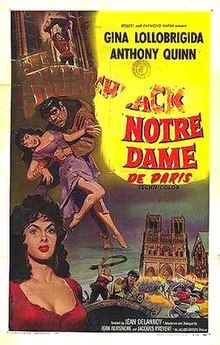| The Hunchback of Notre Dame | |
|---|---|
 French theatrical release poster | |
| Directed by | Jean Delannoy |
| Written by | |
| Based on | The Hunchback of Notre-Dame by Victor Hugo |
| Produced by | |
| Starring | |
| Cinematography | Michel Kelber |
| Edited by | Henri Taverna |
| Music by | |
Production company | |
| Distributed by | Allied Artists Pictures Corporation |
Release date |
|
Running time | 115 minutes |
| Country | Italy/France |
| Language | French |
| Budget | $2 million[2] |
| Box office | $2.25 million (US and Canadian rentals)[3] |
The Hunchback of Notre Dame (in French Notre-Dame de Paris) is a 1956 French-Italian CinemaScope film version of Victor Hugo's 1831 novel, directed by Jean Delannoy and produced by Raymond Hakim and Robert Hakim. It stars American actor Anthony Quinn and Italian actress Gina Lollobrigida. The film is the first version of the novel to be made in color.
In the tradition of many sword and sandal spectacles, Quinn and Lollobrigida are the only two actors in the film who actually speak in English; the rest of the cast is made up of French actors who have had their voices dubbed into English. In the French version both Quinn and Lollobrigida speak French.
Anthony Quinn's portrayal of the hunchback Quasimodo is less disfigured than most other portrayals. Instead of having a huge hump and a hideously deformed face, he only has a small curve in his spine and a slightly deformed face.
The film is one of the few adaptations to use Victor Hugo's original ending; although Esmeralda is killed by a stray arrow rather than hanged. Esmeralda's last words were: "Life is wonderful" ("C'est beau, la vie"). A voiceover narration tells us at the end that several years afterward, an excavation group finds the skeletons of Quasimodo and Esmeralda intertwined in an embrace.
- ^ a b Notre-Dame de Paris Musique de Georges Auric. Sortie le 19 décembre 1956 // cinema-francais
- ^ "It's a Crisis". Variety. 20 June 1956. p. 6.
- ^ "Top Grosses of 1957", Variety, 8 January 1958: 30